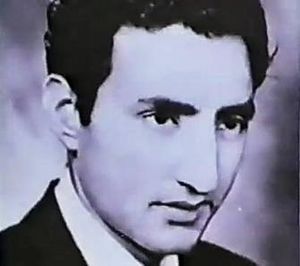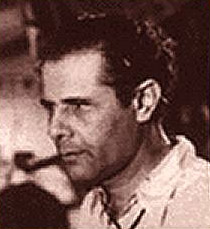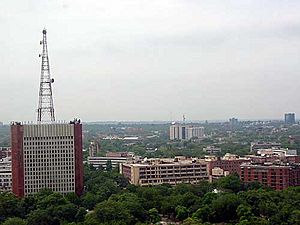G. M. Durrani facts for kids
Quick facts for kids
Ghulam Mustafa Durrani
|
|
|---|---|
 |
|
| Background information | |
| Also known as | G.M.D. Sahab, Durrani Ji, Durrani Sahab, G.M. Sahab |
| Born | September 8th 1919 Peshawar, British India |
| Origin | Mumbai, Maharashtra, India (Nationality-Indian) |
| Died | 8 September 1988 (aged 68–69) Mumbai, Maharashtra, India |
| Genres |
|
| Occupation(s) | Singer, Actor, Music director, Composer, Radio Drama Artist |
| Instruments | Vocalist, Harmonium, Tanpura |
| Years active | 1935–1978 |
| Labels |
|
Ghulam Mustafa Durrani (born in 1919 – died September 8, 1988), also known as G. M. Durrani, was a talented Indian artist. He was famous as a playback singer (meaning he sang for actors in movies), an actor, a music director, and a radio drama artist.
Durrani worked at radio stations in Lahore, Delhi, and Mumbai. He spoke Pashto, his native language, but was also very good at Hindi, Urdu, and Punjabi. He sang in many Indian languages for movies in the 1930s, 1940s, and 1950s. After the 1950s, he sang fewer songs.
He was known for creating his own unique singing style. He didn't just copy other famous singers like K. L. Saigal. G. M. Durrani sang many types of songs, including sad songs, romantic songs, patriotic songs, and religious songs. He was also one of the first Muslim singers to perform Hindu devotional songs.
Contents
Early Life and Family
Ghulam Mustafa Durrani was born in Peshawar, which was part of British India, in 1919. He came from a Pathan family, specifically the Mohammad Zai Durrani group.
His mother passed away when he was very young. His father was educated and artistic but also very strict. His loving grandmother was his only support at home.
Marriage and Family Life
Durrani married an actress named Jyoti, whose real name was Sitara Begum. Jyoti's older sister, Wahidan, was also an actress. Wahidan's daughter, Nimmi, became a big actress in the 1950s.
Durrani's Career Journey
Starting in Peshawar
Durrani's last job in Peshawar was at a painter's shop. There, an artist often hummed tunes by the famous composer and actor Rafiq Ghaznavi. Durrani started copying these songs and got praise from his co-workers. This made him want to practice more.
His father then got him another job at his uncle's motor-part shop. But Durrani's love for music was too strong. He soon ran away from home to Lahore with only a small amount of money.
Moving to Lahore and Mumbai
In Lahore, Durrani took on small jobs and also sang on the radio. This made him famous and passionate about radio singing. His journey then took him to Delhi and finally to Mumbai.
He arrived in Mumbai (now called Mumbai) on April 14, 1935. He managed to get a job at the Mumbai Radio Station, which helped him become known. Soon, filmmakers started asking him to sing for movies.
First Steps in Bollywood
His singing career really took off at AIR (Akashvani (radio broadcaster)), the Indian radio station. A film producer named Sohrab Modi discovered him. Modi gave Durrani his first chance in a movie called Said-e-Havas around 1935 or 1936. This was a historical film with music by Bundu Khan. Durrani sang a ghazal (a type of poem set to music) in the movie.
Working in Delhi
When Durrani first came to Bombay, singers had to act on screen while singing. He didn't like this and decided not to work in films for a while. He faced difficulties and joined the Delhi Radio Station of AIR.
In Delhi, he met the poet Behzad Lakhnavi. Many of Lakhnavi's ghazals were sung by the famous "Queen of Ghazals," Begum Akhtar.
Return to Mumbai and Playback Singing
Later, Durrani moved to the Mumbai Radio Station. There, he met Zulfiqar Ali Bukhari, a very important person in broadcasting. Durrani looked up to Bukhari as his teacher.
Durrani's salary at the radio station was fixed at Rs. 40 per month. He became one of the best radio drama artists. After three years, his salary increased to Rs. 70. But soon, films called him back.
Around 1939-1940, the idea of playback singing began. This meant singers could record songs separately, and actors would lip-sync them on screen. Durrani was one of the first to lend his voice for a film called Bahurani (1940). The music director was Rafiq Ghaznavi.
At that time, radio artists were not allowed to do private recordings. But Ghaznavi really wanted Durrani to sing. So, Durrani agreed on two conditions: the recording had to be on a Sunday night when no one else was around, and his name should not appear in the movie credits or on the music discs. He was paid Rs. 75 for the song, which was more than his monthly radio salary. So, on December 31, 1940, he left his radio job to focus on his film career.
After that, he sang for many famous music directors like Khawaja Khurshid Anwar, Naushad, and Alla Rakha. He sang for films like Mirza Ghalib, Humlog, and many others. He became very popular. Many new singers started their careers with him and were inspired by him.
Mohammed Rafi, a legendary singer, was greatly influenced by G. M. Durrani. In his early days, Rafi even imitated Durrani's style. In 1944, Rafi recorded his first Hindi song for the film Gaon ki Gori with G. M. Durrani.
Geeta Dutt also started her career with a duet with G. M. Durrani in the film Do Bhai. Similarly, Lata Mangeshkar sang her first song for composer Naushad as a duet with G. M. Durrani.
Durrani's Popularity and Influence
In the 1940s, G. M. Durrani was one of the most famous playback singers. He made his own unique style, which inspired many singers who came after him. His soulful singing reminded people of Talat Mahmood's voice.
Mohammed Rafi was especially influenced by Durrani. He even sang duets with his idol, like "Humko Hanste Dekh Zamana Jalta Hai" (1956) and "Khabar Kisi Ko Nahiin, Woh Kidhar Dekhte" (1950).
Durrani felt his first truly famous song was "Duniya Mein Sab Jode Jode" from the film Sharda (1942), composed by Naushad.
However, the song that made him a huge sensation was "Neend Hamaari Khwaab Tumhaare Kitne Meethe Kitne Pyaare" from the movie Nai Kahani. This song was played everywhere and made listeners very excited. It remains a timeless melody for fans of Indian cinema.
Years later, in 1978, a program celebrated fifty years of Indian talkies. They invited Durrani to sing this song again. Even though many people had forgotten him, his voice was still amazing, and he received great applause.
Film Work: Acting and Music Direction
As an Actor
G. M. Durrani also acted in several films. Some of his roles were in:
- Mumtaz Mahal (1957)
- Bhola Shikaar (1958)
- Hum Log (1951)
- Aasman (1952)
- Lal Patthar (1971)
- Besharam (1978)
As a Music Director
Durrani also composed music for films. He assisted his friend Naushad and got a big break with the movie Nai Duniya (1942).
He composed songs for these films:
- Vijay Laxmi (1943)
- Angoori (1943)
- Bhagya Laxmi (1944)
- Dhadkan (1946)
Selected Songs by G. M. Durrani
Durrani sang many songs throughout his career. Here are a few examples of his solo and duet performances:
Solo Songs
- Nai Kahani (1943) - "Neend Hamari Khwab Tumhare"
- Chand (1944) - "Ae Dil Mujhe Rone De"
- Nargis (1946) - "Ye To Bata Mere Khuda"
- Sharda (1942) - "Duniya Mein Sab Jodey Jodey"
- Doli (1947) - "Khel Nahi Gir Gir Ke Sambhalna"
- Khel (1950) - "Hamein Ab Ye Jeena Ghawara"
Songs with Other Singers
Durrani sang with many famous artists.
- With Lata Mangeshkar: "Haye Chhore Ki Jaat" (1949), "Gaaye Chala Jaa" (1951)
- With Mohammed Rafi: "Khabar Kisi Ko Nahin" (1950), "Humko Hansta Dekh Zamana Jalta Hai" (1956)
- With Geeta Dutt: "Aaj Preet Ka Naata Toot Gaya" (1947)
- With Shamshad Begum: "Ek Yaad Kisiki Yaad Rahi" (1946), "Nazar Phero Na Humse" (1951)
- With Noor Jehan: "Haath Seene Pe Jo Rakh Do" (1947)
- With Mukesh (singer): "Aise Mein Koi Chham Se" (1950)
- With Suraiya: "Haa Kyun Dil Mein Mere" (1948)
Different Song Styles
Patriotic Songs
Durrani sang many songs that celebrated India.
- Koshish - "Hindustan Waalon Geeta Ke Barq Uthaao"
- Gaon Ki Gori (1945) - "Hindustan Ki Khatir"
Hindu Devotional Songs
G. M. Durrani was one of the first Muslim singers to perform Hindu devotional songs.
- Bharat Milap (1942) - "Raghukul Reet Sada Chali Aayi"
- Namaste (1943) - "Aan Milo Morey Shyaam"
- Ramayan (1954) - "Ram Chale Ram Chale Ban Chale Ram Raghuveer"
Muslim Devotional Songs
- Awara Shahzadi (1956) - "Nabi Ne Chahne Wale Nirali Shaan"
Qawwali and Ghazal
He also sang Filmi qawwali and Filmi-ghazal songs, which are popular forms of music in India.
- Beqasoor (1950) - "Khabar Kisi Ko Nahin" (Qawwali)
- Ghayal (1951) - "Hazaron Khwahishein Aisi" (Ghazal)
Punjabi and Pashto Songs
In the 1940s and 1950s, G. M. Durrani was a very important Punjabi singer and actor. He had his own unique style that inspired many later singers like Mohammed Rafi and Talat Mahmood.
- Lara Lappa - "Mela Do Din Da" (Punjabi, with Shamshad Begum)
- Mayin pa ta yam (1940s) - (Pashto song)
Later Life and Death
G. M. Durrani became very interested in spirituality later in his life. He slowly started to leave the film industry. In an interview in 1978, he said he grew tired of the busy and materialistic world of Bollywood. He wanted a simpler life.
He began to avoid film events and even grew a beard so people wouldn't recognize him easily. He sold his expensive belongings and gave money to those in need. Eventually, he moved into a small house and opened a general store after taking a loan.
Ghulam Mustafa Durrani passed away in Mumbai on September 8, 1988.
Images for kids
See also
- Bulo C. Rani
- List of Indian playback singers
- List of Pashto-language singers





